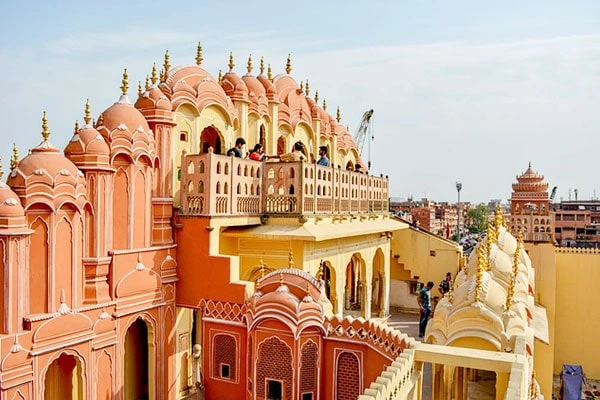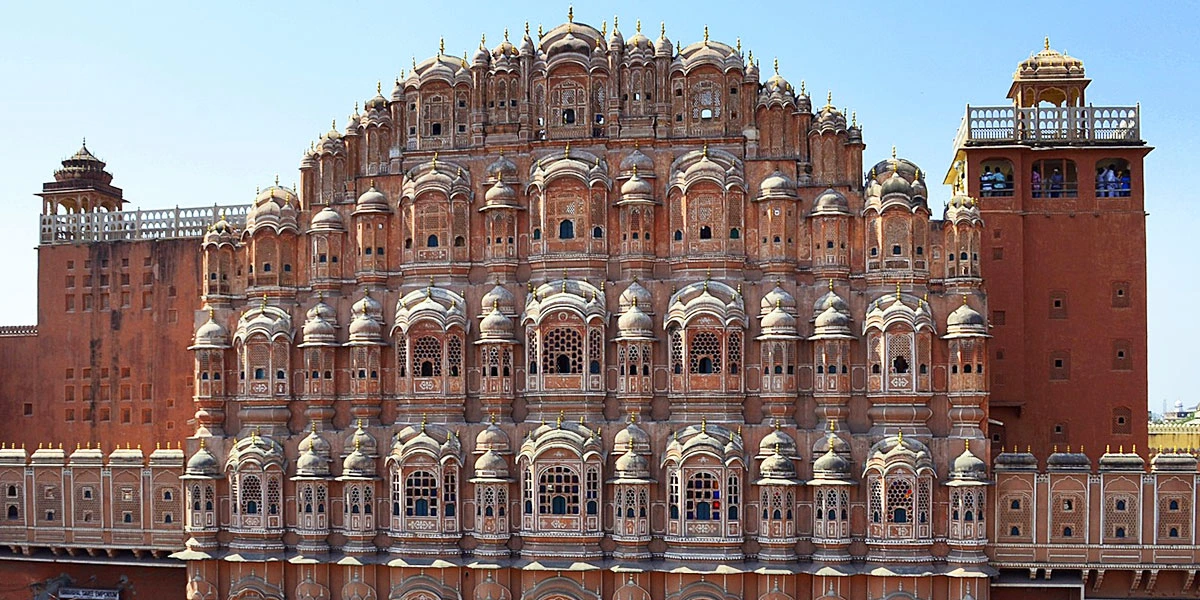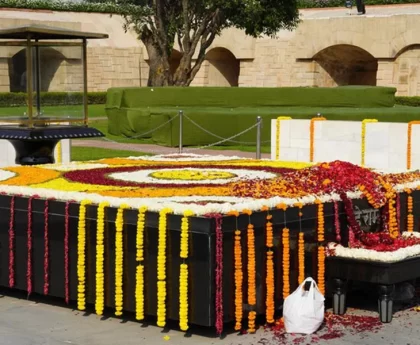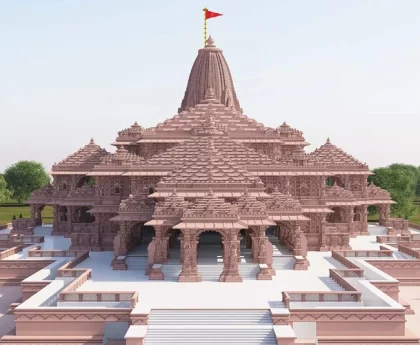Hawa Mahal, also known as the “Palace of Winds,” is a stunning architectural marvel located in Jaipur, Rajasthan, India. It is a prominent landmark and a symbol of Jaipur’s rich cultural heritage. The history of the Hawa Mahal is closely tied to the historical and architectural development of the region.
Construction and Purpose:
The Hawa Mahal was built in 1799 by Maharaja Sawai Pratap Singh, a ruler of the Kachwaha Rajput dynasty. The palace was designed by Lal Chand Ustad, an architect who conceptualized its unique and intricate facade. The primary purpose of the Hawa Mahal was to serve as a “jharokha” or an ornate window structure that allowed royal ladies to observe and enjoy street processions and daily life without being seen themselves. The palace’s unique design with numerous small windows and screens provided ventilation, allowing cool breezes to flow through and keeping the interiors comfortable in the hot desert climate of Rajasthan.
Architectural Features:
The most distinctive feature of the Hawa Mahal is its intricate facade, which comprises five stories of beautifully designed windows, balconies, and latticework. The palace resembles a honeycomb with its 953 small windows, known as “jharokhas,” that are intricately carved and decorated. These windows are a blend of Rajput and Islamic architectural styles. The facade is made of pink sandstone, which is the dominant building material used in many structures in Jaipur.
Historical Significance:
The Hawa Mahal is a testimony to the opulent lifestyle of the royal families of Rajasthan and their commitment to preserving their privacy while maintaining a connection to the outside world. It served as an observatory and a space for the royal women to enjoy the festivities and processions on the streets below.
Tourist Attraction:
Today, the Hawa Mahal is one of the most popular tourist attractions in Jaipur and Rajasthan. It offers visitors a glimpse into the artistic and architectural prowess of the past. The palace is also a part of Jaipur’s cityscape and is often featured in various cultural and travel depictions of the region.
The Hawa Mahal stands as a tribute to the architectural creativity of its time and continues to capture the imagination of people worldwide with its unique design and historical significance.
Here are the official Websites:-
Best Time To Visit Hawa Mahal, Jaipur
The best time to visit the Hawa Mahal in Jaipur, Rajasthan, largely depends on the weather and the overall experience you are seeking.
Here are the recommended times to visit:
- Winter (October to February): This is generally considered the best time to visit Jaipur and the Hawa Mahal. The weather is cool and pleasant, making it comfortable for sightseeing. Daytime temperatures are moderate, and you can explore the Hawa Mahal and other attractions without worrying about extreme heat. The months of October and November, as well as February, are particularly popular for tourists.
- Spring (March and April): Spring is another good time to visit, especially in March when the weather remains pleasant before the heat of summer sets in. The Hawa Mahal and the city of Jaipur are adorned with vibrant flowers, and the evenings are usually pleasant.
- Early Monsoon (July and August): While the monsoon season can bring some rain to the region, visiting in early monsoon can offer a unique experience. The surroundings are lush and green, and the rain-washed architecture of the Hawa Mahal can be quite charming. Just be prepared for occasional showers.
- Avoid Summer (May and June): The summer months in Jaipur can be extremely hot, with temperatures soaring well above 100°F (38°C) and higher. Visiting during this time can be uncomfortable and challenging, especially when exploring outdoor attractions like the Hawa Mahal.
- Post-Monsoon (September): September can be a bit unpredictable in terms of weather, as it marks the transition from monsoon to autumn. It might still have some lingering rain, but if you don’t mind a little unpredictability, it can be a quieter time to visit.
Remember to check the local weather forecast before planning your visit. Regardless of the season, it’s advisable to visit the Hawa Mahal early in the morning to avoid crowds and to experience the palace in a more serene atmosphere. Additionally, the soft morning light can make for beautiful photography.
Keep in mind that Jaipur, and the Hawa Mahal by extension, can attract a high number of tourists during peak seasons. If you prefer a quieter experience, consider visiting during the shoulder seasons (spring and early monsoon) when the weather is still pleasant, and there are fewer crowds.
Facts of Hawa Mahal
Certainly, here are some interesting facts about the Hawa Mahal:
- Unique Facade: The Hawa Mahal’s most distinctive feature is its intricate facade with 953 small windows, known as “jharokhas,” that are intricately carved and decorated. The design resembles a honeycomb and is meant to allow cool breezes to flow through the palace, providing natural ventilation.
- Five Stories: The Hawa Mahal is a five-story structure, with each floor having a different height. The upper floors are narrower than the lower ones, creating a pyramid-like shape.
- Architectural Style: The architectural style of the Hawa Mahal is a blend of Rajput and Islamic influences, reflecting the cultural diversity of Jaipur.
- Built for Royal Ladies: The Hawa Mahal was built in 1799 by Maharaja Sawai Pratap Singh as a place for the royal ladies to observe street processions and daily life without being seen themselves. It allowed them to maintain their purdah (veiled) system while still participating in public events.
- Pink Sandstone: The palace is constructed primarily from pink sandstone, which is a hallmark of many buildings in Jaipur. The use of pink sandstone gives the city its nickname, the “Pink City.”
- Lal Chand Ustad: The architect behind the design of the Hawa Mahal is believed to be Lal Chand Ustad. He was also responsible for designing several other structures in Jaipur.
- Pyramid Shape: The Hawa Mahal is often described as a crown or a tiara due to its unique pyramid-like shape and its association with the royal lifestyle.
- Street View and Interior: While the exterior of the Hawa Mahal is widely recognized, the interior is relatively simple. It consists of a series of chambers and passages. Visitors can explore the museum located inside the palace, which showcases artifacts related to Jaipur’s history and culture.
- Night Illumination: The Hawa Mahal is beautifully illuminated at night, making it a stunning sight when viewed after sunset.
- Tourist Attraction: The Hawa Mahal is one of the most iconic tourist attractions in Jaipur and a popular destination for both domestic and international visitors.
- UNESCO World Heritage Site: The Hawa Mahal is part of the “Hill Forts of Rajasthan” UNESCO World Heritage Site designation, which includes several forts and palaces across Rajasthan.
- Cultural Importance: The Hawa Mahal is not just an architectural marvel; it symbolizes the rich history, culture, and heritage of Jaipur and the state of Rajasthan.
These facts highlight the unique architectural features and historical significance of the Hawa Mahal, making it a must-visit attraction for anyone exploring the Pink City of Jaipur.
Q: When was it built?
A: Hawa Mahal was built in 1799 A.D by Maharaja Sawai Pratap Singh.
Q: Where is the entrance?
A: The entrance is through the City Palace where doors open into an open spacious courtyard with two-storeyed buildings on three sides.
Q: How many windows are there in Hawa Mahal?
A: There are 953 windows.
Q: Do you know that Hawa Mahal has no foundation?
A: That’s correct. Hawa Mahal was built without foundation. In fact, it is the tallest building in the world without a foundation. The five-storey building managed to maintain upright because it is curved. Just another masterpiece of Rajput and Mughal architecture.
Q: What is the meaning of Hawa Mahal?
A: The word “Hawa” means wind or breeze and “Mahal” is palace. So Hawa Mahal is the palace of breeze.
Q: What is the purpose of building Hawa Mahal?
A: Royal ladies were not to be seen by the public. The palace was built such that the ladies can watch festival celebrations and all other activities on the street without being seen.
Q: Why are there so many windows?
A: There are two purposes for the seemingly excessive number of windows. First, when there are windows everywhere, the royal ladies can look out to the street anywhere they want. Secondly, the windows allow breeze to flow through and help to keep the palace cool. It thus makes it an ideal summer palace.
Q: What style of architecture is it?
A: Hawa Mahal exhibits a unique combination of Mughal and Rajput architectural styles.
Q: What is it made of?
A: Hawa Mahal is carved out of red and pink sandstone.
Q: Does it relate to any god?
A: The palace is devoted for Krishna and thus in the shape of Lord Krishna’s crown.
Why is Jaipur Called Pink City ?
Jaipur is often referred to as the “Pink City” due to the distinct pink color of many of its buildings and structures. The city’s pink hue is not just a random aesthetic choice, but it has historical and cultural significance behind it.
The story behind Jaipur’s nickname, the “Pink City,” dates back to the 19th century:
In 1876, Maharaja Sawai Ram Singh II ordered the city to be painted pink to welcome the Prince of Wales (later King Edward VII) on his visit to Jaipur. The color pink was chosen as it symbolizes hospitality and is associated with warmth and welcome. The Maharaja wanted to create a lasting impression of the city’s hospitality and make it stand out among other cities.
The entire old city of Jaipur, including its historic buildings, city walls, and markets, was painted pink, giving it a unique and uniform appearance. This decision to paint the city in a single color was unprecedented and caught the attention of people far and wide.
Since then, the tradition of maintaining the pink color has been upheld, and new buildings constructed within the old city area are required to follow the same pink color scheme. The distinct pink hue has become an iconic feature of Jaipur’s architecture and urban landscape.
The Pink City’s historical and cultural significance, combined with its vibrant markets, palaces, and forts, makes it one of the most popular tourist destinations in India. Visitors from around the world come to experience the charm and unique character of Jaipur, the “Pink City.”

What is About The Hawa Mahal?
The Hawa Mahal, also known as the “Palace of Winds,” is a unique and iconic architectural marvel in Jaipur, Rajasthan, India. Several aspects make the Hawa Mahal special and distinct:
- Architectural Design: The most striking feature of the Hawa Mahal is its intricately designed facade. The palace’s five stories are adorned with a staggering 953 small windows, known as “jharokhas,” each intricately carved and decorated. This design allows for the circulation of cool air, offering natural ventilation and keeping the palace comfortable in the hot desert climate of Rajasthan.
- Ventilation and Airflow: The unique design of the windows and latticework was ingeniously crafted to create a “venturi effect.” This effect funnels the breeze through the windows, creating a cooling breeze within the palace even during the scorching heat of summer.
- Historical Significance: The Hawa Mahal was built in 1799 by Maharaja Sawai Pratap Singh as a place for the royal women to observe street processions and daily life without being seen themselves. This architectural gem allowed them to maintain their privacy and purdah (veil) system while still engaging with the outside world.
- Symbol of Jaipur: The Hawa Mahal is an iconic symbol of Jaipur and is featured prominently in the city’s tourism promotion and branding. Its unique architecture and distinct pink color contribute to Jaipur’s nickname, the “Pink City.”
- Blend of Architectural Styles: The Hawa Mahal showcases a blend of Rajput and Islamic architectural styles, reflecting the cultural diversity and artistic sensibilities of the region.
- Photography and Aesthetics: The intricate jharokhas, the symmetrical design, and the delicate details of the Hawa Mahal make it a favorite subject for photographers, artists, and travelers seeking to capture the essence of Rajasthan’s heritage.
- Tourist Attraction: The Hawa Mahal is one of the most visited tourist attractions in Jaipur. Visitors come from around the world to marvel at its unique design, learn about its history, and experience the architectural brilliance firsthand.
- Night Illumination: The Hawa Mahal is beautifully illuminated at night, adding to its enchanting ambiance and making it a breathtaking sight for both tourists and locals.
- Cultural Heritage: As part of the “Hill Forts of Rajasthan” UNESCO World Heritage Site designation, the Hawa Mahal contributes to the preservation and recognition of the rich cultural heritage of the region.
- Symbol of Hospitality: The pink color of the Hawa Mahal symbolizes hospitality, making it an inviting and welcoming sight for visitors exploring the streets of Jaipur.
In summary, the Hawa Mahal’s unique architectural design, historical significance, cultural importance, and aesthetic beauty make it a special and cherished landmark that captures the essence of Jaipur’s rich heritage and charm.
Why Are There no Stairs in Hawa Mahal ?
The Hawa Mahal, or the “Palace of Winds,” is known for its intricate facade with numerous small windows, balconies, and latticework. While the exterior of the Hawa Mahal is a remarkable architectural feat, the interior of the palace is relatively simple and lacking in elaborate rooms or staircases. There are a few reasons for the absence of stairs within the Hawa Mahal:
- Purpose and Design: The Hawa Mahal was primarily built as an observatory for the royal women, who could watch street processions and daily life from behind the latticed windows without being seen themselves. The design of the palace focused on maintaining privacy and providing ventilation through the intricately carved windows. The lack of grand interiors, including staircases, was a deliberate choice to fulfill the palace’s primary function while maintaining its unique facade.
- Ventilation and Airflow: The palace’s design prioritized natural ventilation and cooling. The open windows and latticework allowed cool breezes to flow through the building, creating a comfortable environment in the hot desert climate of Rajasthan. The focus on airflow and ventilation likely influenced the design decisions regarding the interior layout.
- Simplicity and Functionality: The Hawa Mahal’s primary purpose was to serve as an observatory, and its design reflects functionality over elaborate interiors. The palace’s interior was meant to be simple and utilitarian to fulfill its intended role.
- Historical Practices: The architectural practices of the time, combined with the specific requirements of the palace, contributed to the absence of grand staircases. The Hawa Mahal was constructed in the late 18th century, and architectural preferences and design principles during that period influenced the layout of the building.
It’s important to note that while the interior of the Hawa Mahal may lack the opulent features commonly associated with palaces, its significance lies in its unique architectural design, historical role, and the symbolic representation of the Rajput culture and heritage. Visitors to the Hawa Mahal can explore its chambers and passages, gaining insight into the practical aspects of its design and the historical context in which it was built.
Other Places to Visit Near Jaipur
If you don’t like this article/post please share your feedback.





